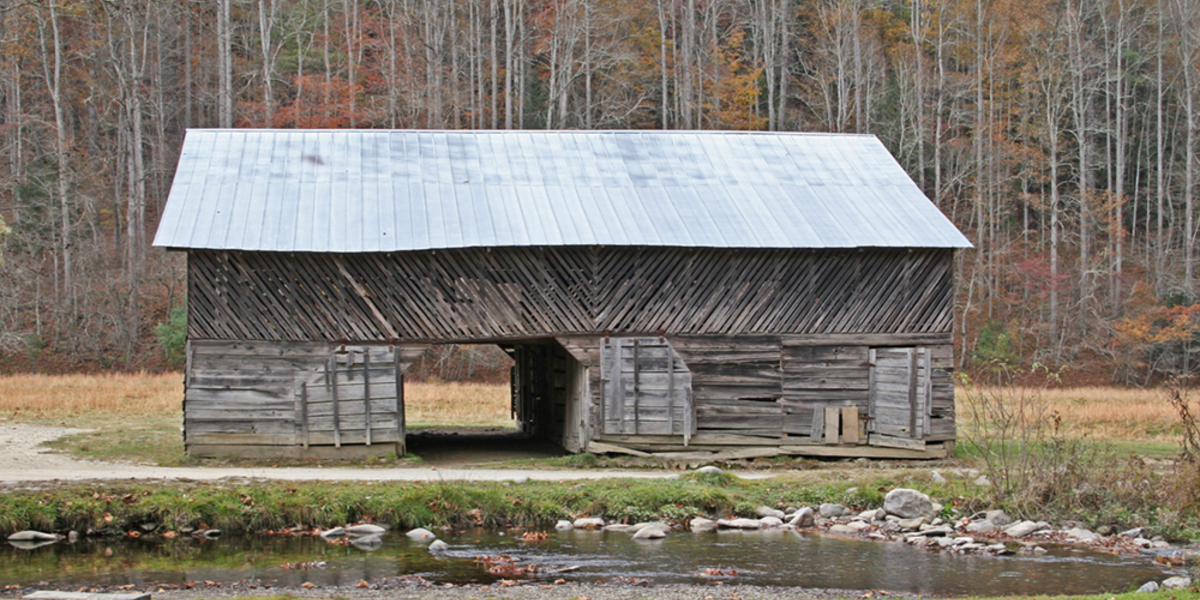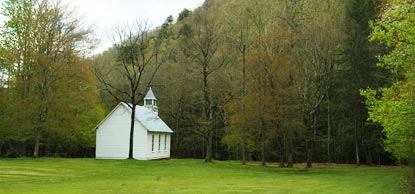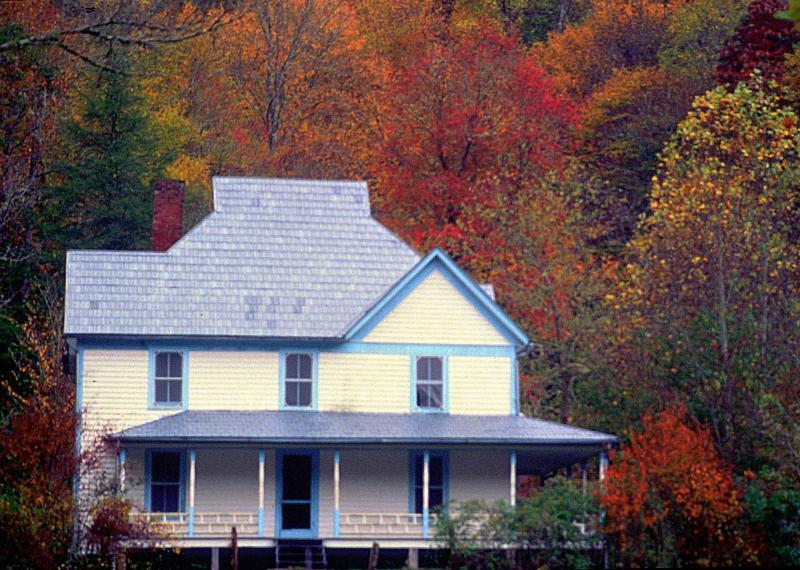
There's no shortage of picturesque valleys in the Smoky Mountains. Even though most--including Wears Valley--are pretty easy to discover, the Cataloochee Valley is an area that's more rugged and somewhat detached from civilization. But don't let that deter you from visiting this beautiful area in Western North Carolina, check out our map of Cataloochee. It's truly a place like no other anywhere in the Great Smoky Mountains National Park. The rich history of Cataloochee and the diverse and abundant wildlife found throughout this valley are a good hint of just how special and unique of a place this is and man, does it have a story to tell!

The Word "Cataloochee"
The word “Cataloochee” is a Cherokee term that, according to legend, refers to a row of trees along the ridges that surround the area. To familiarize you with the area, there's three distinct valleys that make up Cataloochee. There's Little Cataloochee, Big Cataloochee, and Caldwell Fork. The three valleys are split by Noland Mountain and Big Fork Ridge. They run beside Sterling Ridge and the Cataloochee Divide. If you're driving to the area, the easiest route to take would be I-40 to Exit 20 in North Carolina, and after a short drive on Route 276, turn onto Cove Creek Road. Here you should have an easy time following the signs for 11 miles until you reach the valley.
Early Inhabitants
Early inhabitants of the valley were the Cherokee. With continued fighting as part of the Cherokee/American wars, which ended with the signing of the Treaty of Holston in 1791. This gave the United States government control of the lands in the Cataloochee Valley. The terms of the treaty stated that the U.S. government would work with the Cherokee. In order to help provide a stable relationship, Cherokee would turn over all criminals and the Government would let the Cherokee stay on their lands. Of course, as long they maintained the peace. Even though the Cherokee had the right to punish any American who settled on their land, many opted to take a different approach. They developed friendships with the early settlers. Unfortunately for the Cherokee--and like many other treaties signed during these conflicts--the treaty lasted just seven years and gave Americans who settled here illegally full control of the land.
Early settlements in the Cataloochee Valley were used heavily by Americans in the way of free ranging livestock. The first land purchase was made by Henry Caldwell. It made full use of the grassy balds to establish herding camps. The Caldwells continued growing their livestock here near Big Cataloochee. This lasted through several generations until the founding of the Great Smoky Mountain National Park. The founding forced them off the land in the 1930’s.
Palmer Family
Not far away, in a different part of Big Cataloochee, lived the Palmer family who continued to live here until the founding of the National Park. Arriving here in 1838 seeking a fresh start from a life of drinking and gambling, George "Turkey George" Palmer and his family lived and prospered in the Cataloochee valley and as time passed became prominent members in the Cataloochee community. The house that Mr. Palmer built in 1860--now called the Palmer House which is maintained by the National Park Service, is a dog-trot house which was basically two log cabins joined together. Their homestead also included some outbuildings, a barn and a springhouse.
What you see here today was fancied up in the early 1900’s. It was modernized with the addition of siding on the outside and paneling on the inside. When the house was built, the Palmers owned an incredible 750 acres of land. One only has to visit the area to know of the prominence of the Palmer family. Many things in Cataloochee named after the Palmer family including the Palmer Chapel, Palmer Creek, Palmer Lodge, and Boogerman Trail named after Robert “Boogerman” Palmer. The Palmer buildings are now tourist attractions in the Park visited by thousands each year.

The Caldwell House
The Hiram Caldwell House is a reminder of how times were for some of the residents of this small but thriving and happy community. The house was completed around 1906 and appeared to have comfortably housed the family for many years. The land around the house also had several outbuildings, a barn and springhouse. The Caldwell house was one of approximately 200 buildings in the Cataloochee valley that housed residents in the early 1900’s though, only a few of them remain today
The Roads
Roads are sometimes a forgotten aspect of life in the Smoky Mountains. The people of the Cataloochee Valley made good arguments of their need for a road with the growing population of the area at more than 100 people by the turn of the 1800’s. In 1825 the county gave the go-ahead for the construction of a road between Cove Creek and Cataloochee. Apparently, this road was only a minor improvement over the previous trail that was here. So the Cataloochee Turnpike--the new, improved road and the official name was constructed from 1854-1856. However, as you can see on our map of Cataloochee, there are still a mix of roadways and trails to see the unique beauty of the Cataloochee valley.
The Civil War
Luckily, Cataloochee sat in a remote area of the Smoky Mountains also meant that the destruction of the Civil War largely didn’t affect the lives of the people here; although many families did lose loved ones in the war. While most of Southern Appalachia was the home of much pro-Northern sentiments, this remote area was fiercely pro-Confederate. Cataloochee’s setting made it an ideal hideout for soldiers who deserted their group and pro-Union sympathizers; some of which were captured and eventually executed. After the war, people mostly resumed their normal lives with chores and keeping up with news on the outside world. The only real problems that seemed to exist were rebuilding the economy. This was aided with the building of railroads in the 1870’s. It included replacing the saved Confederate money that was now worth nothing.
Now a bustling, thriving mountain community, the Cataloochee Valley boasted some 764 residents by the year 1900. It grew to well over a thousand just a decade later making it the largest community in the Smoky Mountains. This growing population proved bothersome when it came to accommodating students to the Cataloochee School. As powerful and influential members of the community, Hiram and George Caldwell were part of a delegation to visit Waynesville, North Carolina seeking to get a new school built. Unfortunately, as described by Hattie Caldwell Davis--who was born in the valley--they were rejected and decided to burn down the school.
Due to mandatory attendance laws the North Carolina government was forced to agree the next time. Beech Grove School, which still stands today, and the other two schools in the area were known to follow the guidelines set forth by North Carolina. They educated the children in the subjects of reading, writing, spelling, arithmetic, geography, and grammar. This provided children with a well-rounded and comprehensive education. It gave them a leg up on their peers in other communities in the region.
Apple Houses
While fertile farmland provided for a steady and very busy lifestyle that enhanced the lives of the people living in Cataloochee, the 20th century brought forth a new way to earn a decent living for the residents--apples. The people figured with the amount of trees that were in the area--and the cool climate--it was a perfect place to grow some apple trees. It was a nice cash crop for families, but most used it as a side job to supplement the farm. Will Messer built one of the first communal applehouses in Cataloochee around 1910. However, his very own applehouse can actually be seen up close at the Oconaluftee Visitor Center. It is the location for the Mountain Farm Museum--a neat display of preserved buildings for early inhabitants of the Smoky Mountains.
Religion
Religion in Cataloochee wasn’t much different than other areas of the Smoky Mountains. Church was always known to be an important part of people’s lives. While Sunday school for the children was held every week, church worship services were normally held just once a month because mostly circuit riding preachers performed the services. There were traveling preachers who would "ride the ciircuit" and hold church worship services for the Baptists and Methodists in small rural areas; however, if a preacher was planning to stay in town awhile, Sunday services were held twice a day. Perhaps this was to make up for lost Sunday services.
Moonshine
You can’t talk about life in the mountains without mentioning moonshine as a way of life. But, here in the Cataloochee Valley people didn’t simply make moonshine as a means of support. No, they did the one thing that many wish they could’ve done more with the shine they made; they drank it. Yes, it’s true. The fact is, with so many resources at their disposal, moonshine didn’t need to be sold by most families. It’s been estimated that more than nine out of ten households in Cataloochee used it for personal enjoyment. It was used for ailments too, since life back then was so hard on the body, very few people here needed to sell moonshine. Even during Prohibition, when the demand was at its highest.
Another benefit to the Cataloochee area was the lack of logging in the area prior to the National Park’s founding. The logging companies stripped much of the area bare, but it never quite reached Cataloochee Valley. Some of the residents here actually worked for a few of the companies. So that gives you an idea of how indifferent some of the residents were to this environmental concern.
Tourism and Cataloochee Ranch
Finally, the years leading up to the designation of the area as a National Park saw an influx of tourism that also boosted the economy of the valley. Some of the residents saw this and decided to build extra rooms on their homes. This was to provide accommodations to travelers wondering where they could find this mineral spring that was supposed to bring back their youth. The Cataloochee Ranch was one prominent hotel built during this time by Tom and Judy Alexander. It had ten rooms and was open from April 15 to October 15. It had rates that would overjoy most--alright, probably all--tourists today. Starting price was $2.75 a night for the cheapest room and $5.00 for a luxury room. Soon it became clear that even before the modern tourism boom, visitors to the Smoky Mountains could always count on some great Southern hospitality to make their stay worthwhile.
It has been well documented how difficult it was for people to accept the fact that they could not live here anymore. Some people accepted payment from the government and moved on to other areas, but some had to almost literally be dragged out; some went to court and held out for more money, and often they were successful. In the end--and after a lot of bargaining--most people ended up seeing the benefit of moving away, as the lands and the mountainside were largely preserved.
The National Park
In recent times, the National Park designed a program in an effort to reintroduce elk into the area. The first 25 elk came from The Land Between the Lakes National Recreation Area. It was designated by President Kennedy in 1963 and under the oversight of the United States Forest Service. However, most of the funding came from The Rocky Mountain Elk Foundation. It was a conservation organization that helps to restore wildlife and their habitats. Each and every elk--which recent numbers have shown to be at nearly 200--are tagged and monitored by the Park.
This becomes quite a thrill for the visitor as they have been known to be out and crossing paths in the Smokies in the Spring and Fall months. It is illegal to come within 150 feet of the elk, which are definitely not afraid of humans. Nearby Cherokee often has elk on their roadways during this time. It is not unusual to encounter one despite their small population numbers in the Smokies.
As you may have learned from reading other articles about different areas of the Smokies, people have toiled long hours on farms and in rugged environments to survive; this was no different in Cataloochee Valley. Through the years, the land was very kind to early settlers, and even though there was some hardships--whether it was from downturns in the economy or raids from villagers or Natives--the people did well to give themselves a good life until they could no longer reside in this remote area of the Smokies. Image Credit: NPS.gov
